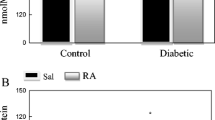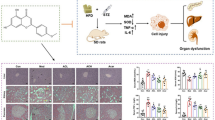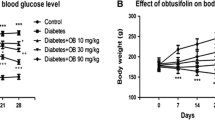Abstract
Persistent hyperglycemia and elevated levels of free fatty acids (FFA) contribute to oxidative stress, a proximate cause for the onset and progression of diabetes and its complications. The present study was hypothesized to evaluate the anti-diabetic potential of Rosmarinic acid (RA) during high-fat diet (HFD)—streptozotocin (STZ)-induced type 2 Diabetes (T2D) in wistar albino rats. Oral administration of RA (100 mg/kg b.w) significantly (p < 0.05) increased the insulin sensitivity index (ISI0,120), while the levels of blood glucose, HbA1c, advanced glycation end products (AGE), TNF-α, IL-1β, IL 6, NO, p-JNK, P38 MAPK and NF-κB were significantly reduced, with a concomitant elevation in the plasma insulin levels in diabetic rats. Furthermore, RA treatment significantly (p < 0.05) reduced the levels of triglycerides, FFA and cholesterol in serum, and reduced the levels of lipid peroxides, AOPP’s and protein carbonyls in the plasma and pancreas of diabetic rats. The diminished activities of pancreatic superoxide dismutase (SOD), catalase (CAT), glutathione peroxidase (GPx) and glutathione-S-transferase (GST) and the decreased levels of plasma ceruloplasmin, vitamin C, vitamin E and reduced glutathione (GSH) in diabetic rats were also significantly (p < 0.05) recovered upon RA treatment denoting its antioxidant potential which was confirmed by Nrf-2, hemeoxyenase (HO-1) levels. Histological, ultrastructural and immunohistochemical data demonstrate that oral administration of RA protects pancreatic β-cells from oxidative niche in HFD-STZ-induced experimental diabetes. Our findings suggest that the oral treatment with RA alleviates pancreatic β-cell dysfunction and glucolipotoxicity-mediated oxidative stress during HFD-STZ-induced T2DM, perhaps through its antioxidant potential.










Similar content being viewed by others
References
Brownlee M (2005) The pathobiology of diabetic complications: a unifying mechanism. Diabetes 54:1615–1625
Fiorentino TV, Prioletta A, Zuo P, Folli F (2013) Hyperglycaemia induced oxidative stress and its role in diabetes mellitus related cardiovascular diseases. Curr Pharm Des 19(9):5695–5703
Palsamy P, Subramanian S (2010) Ameliorative potential of resveratrol on proinflammatory cytokines, hyperglycemia mediated oxidative stress, and pancreatic beta-cell dysfunction in streptozotocin- nicotinamide-induced diabetic rats. J cell physiol 224:423–432
Robertson RP (2004) Chronic oxidative stress as a central mechanism for glucose toxicity in pancreatic islet beta cells in diabetes. J Biol Chem 279:42351–42354
Donath MY, Böni-Schnetzler M, Ellingsgaard H, Halban PA, Ehses JA (2010) Cytokine production by islets in health and diabetes: cellular origin, regulation and function. Trends Endocrinol Metab 21:261–267
Andreasen AS, Kelly M, Berg RMG, Møller K, Pedersen BK (2011) Type 2 diabetes is associated with altered NF-κB DNA binding activity, JNK phosphorylation, and AMPK phosphorylation in skeletal muscle after LPS. PLoS One 6(9):e23999
Scherer R, Godoy HT (2009) Antioxidant activity index (AAI) by the 2,2 diphenyl-1-picrylhydrazyl method. Food Chem 112:654–658
Golbidi S, Ebadi SA, Laher I (2011) Antioxidants in the treatment of diabetes. Curr Diabetes Rev 7(2):106–125
Yu ZW, Li D, Ling WH, Jin TR (2012) Role of nuclear factor (erythroid-derived 2)-like 2 in metabolic homeostasis and insulin action: a novel opportunity for diabetes treatment? World J Diabetes 3(1):19–28
Fadel O, El Kirat K, Morandat S (2011) The natural antioxidant rosmarinic acid spontaneously penetrates membranes to inhibit lipid peroxidation in situ. Biochim Biophys Acta 1808:2973–2980
Scheckel KA, Degner SC, Romagnolo DF (2008) Rosmarinic acid antagonizes activator protein-1-dependent activation of cyclooxygenase-2 expression in human cancer and nonmalignant cell lines. J Nutr 138:2098–2105
Zhu F, Asada T, Sato A, Koi Y, Nishiwaki H, Tamura H (2014) Rosmarinic acid extract for antioxidant, antiallergic, and α-glucosidase inhibitory activities, isolated by supramolecular technique and solvent extraction from Perilla leaves. J Agric Food Chem 62(4):885–892
Soobrattee MA, Neergheen VS, Luximon-Ramma A, Aruoma OI, Bahorun T (2005) Phenolics as potential antioxidant therapeutic agents: mechanism and actions. Mutat Res 579:200–213
Hamaguchi T, Ono K, Murase A, Yamada M (2009) Phenolic compounds prevent Alzheimer’s pathology through different effects on the amyloid-beta aggregation pathway. Am J Pathol 175:2557–2565
Petersen M, Simmonds MS (2003) Rosmarinic acid. Phytochemistry 62:121–125
Jayanthy G, Subramanian S (2014) Rosmarinic acid, a polyphenol, ameliorates hyperglycemia by regulating the key enzymes of carbohydrate metabolism in high fat diet – STZ induced experimental diabetes mellitus. Biomed Prev Nutr 4:431–437
Esteghamati A, Eskandari D, Mirmiranpour H, Noshad S, Mousavizadeh M, Hedayati M, Nakhjavani M (2013) Effects of metformin on markers of oxidative stress and antioxidant reserve in patients with newly diagnosed type 2 diabetes: a randomized clinical trial. Clin Nutr 32(2):179–185
Brand-Williams W, Cuvelier ME, Berset C (1995) Use of a free radical method to evaluate antioxidant activity. LWT Food Sci Technol 28:25–30
Re R, Pellegrini N, Proteggente A, Pannala A, Yang M, Rice-Evans C (1999) Antioxidant activity applying an improved ABTS radical cation decolorization assay. Free Radic Biol Med 26:1231–1237
Debnath T, Park PJ, DebNath NC, Samad NB, Park HW, Lim BO (2011) Antioxidant activity of Gardenia jasminoides Ellis fruit extracts. Food Chem 128(3):697–703
Srinivasan K, Viswanad B, Asrat L, Kaul CL, Ramarao P (2005) Combination of high-fat diet-fed and low-dose streptozotocin-treated rat: a model for type 2 diabetes and pharmacological screening. Pharm Res 52:313–320
Lowry OH, Rosebrough NJ, Farr AL, Randall RJ (1951) Protein measurement with the folin phenol reagent. J Biol Chem 193:265–275
Nayak SS, Pattabiraman TN (1981) A new colorimetric method for the estimation of glycosylated hemoglobin. Clin Chim Acta 109:267–274
Gutt M, Davis CL, Spitzer SB (2000) Validation of the insulin sensitivity index (ISI(0,120)):comparison with other measures. Diabetes Res Clin Pract 47:177–184
Parekh AC, Jung DH (1970) Cholesterol determination with ferric acetate uranyl acetate and sulphuric acid-ferrous sulphate reagents. Anal Chem 42:1423–1427
Foster LB, Dunn RT (1973) Stable reagents for determination of serum triglycerides by a colorimetric Hantzsch condensation method. Clin Chem 19:338–340
Itaya K (1977) A more sensitive and stable calorimetric determination of free fatty acids in plasma. J Lipid Res 18:663–665
Omaye ST, Turnbull JD (1979) Sauberlich HE. Selected methods for the determination of ascorbic acid in animal cells, tissues, and fluids. Methods Enzymol 62:3–11
Desai ID (1984) Vitamin E analysis methods for animal tissues. Methods Enzymol 105:138–147
Ravin HA (1961) An improved colorimetric enzymatic assay of ceruloplasmin. J Lab Clin Med 58:161–168
Sedlak J, Lindsay RH (1968) Estimation of total, protein-bound, and nonprotein sulfhydryl groups in tissue with Ellman’s reagent. Anal Biochem 25:192–205
Misra HP, Fridovich I (1972) The role of superoxide anion in the autoxidation of epinephrine and a simple assay for superoxide dismutase. J Biol Chem 247:3170–3175
Takahara S, Hamilton HB, Neel JV, Kobara TY, Ogura Y, Nishimura ET (1960) Hypocatalasemia: a new genetic carrier state. J Clin Invest 39:610–619
Rotruck JT, Pope AL, Ganther HE, Swanson AB, Hafeman DG, Hoekstra WG (1973) Selenium: biochemical role as a component of glutathione peroxidase. Science 179:588–590
Habig WH, Pabst MJ, Jakoby WB (1974) Glutathione S-transferases. The first enzymatic step in mercapturic acid formation. J Biol Chem 249:7130–7139
Ohkawa H, Ohishi N, Yagi K (1979) Assay for lipid peroxides in animal tissues by thiobarbituric acid reaction. Anal Biochem 95:351–358
Witko-Sarsat V, Friedlander M, Capeillère-Blandin C, Nguyen-Khoa T, Nguyen AT, Zingraff J, Jungers P, Descamps-Latscha B (1996) Advanced oxidation protein products as a novel marker of oxidative stress in uremia. Kidney Int 49(5):1304–1313
Uchida K, Stadtman ER (1993) Covalent attachment of 4-hydroxynonenal to glyceraldehyde- 3-phosphate dehydrogenase. A possible involvement of intra- and intermolecular crosslinking reaction. J Biol Chem 268:6388–6393
Green LC, Wagner DA, Glogowski J, Skipper PL, Wishnok JS, Tannenbaum SR (1982) Analysis of nitrate, nitrite, and [15n] nitrate in biological fluids. Anal Biochem 126:131–138
Glauert M, Lewis PR (1998) Biological specimen preparation for transmission electron microscopy. Practical methods in electron, Microscopy, vol 17. Princeton University Press, New Jersey
Fisman EZ, Alexander A (2010) The ubiquitous interleukin-6: a time for reappraisal. Cardiovasc Diabetol 9:62
Rahimi R, Nikfar S, Larijani B, Abdollahi M (2005) A review on the role of antioxidants in the management of diabetes and its complications. Biomed Pharmacother 59:365–373
Ihara Y, Toyokuni S, Uchida K, Odaka H, Tanaka T, Ikeda H (1999) Hyperglycemia causes oxidative stress in pancreatic beta cells of GK rats a model of type 2 diabetes. Diabetes 48:927–932
Haugaard N (1968) Cellular mechanisms of oxygen toxicity. Physiol Rev 48:311–373
Sanders RA, Rauscher FM, Watkins JB III (2001) Effects of quercetin on antioxidant defense in streptozotocin-induced diabetic rats. J Biochem Mol Toxicol 15:143–149
Cuvelier M, Richard H, Berset C (1992) Comparison of the antioxidative activity of some acid-phenols: structure-activity relationship. Biosci Biotech Biochem 26:324–325
Siddiqui S, Ahsan H, Khan MR, Siddiqui WA (2013) Protective effects of tocotrienols against lipid-induced nephropathy in experimental type-2 diabetic rats by modulation in TGF-β expression. Toxicol Appl Pharmacol 273:314–324
Gu H, Xia X, Chen Z, Liang H, Yan J, Xu F, Weng J (2014) Insulin therapy improves islet functions by restoring pancreatic vasculature in high-fat diet-fed streptozotocin-diabetic rats. J Diabetes 6(3):228–236
Koga K, Shibata H, Yoshino K, Nomoto K (2006) Effects of 50% Ethanol Extract from Rosemary (Rosmarinus officinalis) on α-Glucosidase Inhibitory Activity and the Elevation of Plasma Glucose Level in Rats, and Its Active Compound. J Food Sci 71:S507–S512
Yabe-Nishimura C (1998) Aldose reductase in glucose toxicity: a potential target for the prevention of diabetic complications. Pharmacol Rev 50:21–33
Lu YS, Tian XY, Huang Y, Murugan D, Achike FI, Mustafa MR (2013) Boldine protects endothelial function in hyperglycemia induced oxidative stress through an antioxidant mechanism. Biochem Pharacol 85:367–375
Elgawish A, Glomb M, Friedlander M, Monnier VM (1996) Involvement of hydrogen peroxide in collagen cross-linking by high glucose in vitro and in vivo. J Biol Chem 271:12964–12971
Singh R, Barden A, Mori T, Beilin L (2001) Advanced glycation end-products: a review. Diabetologia 44:129–146
Ott C, Jacobs K, Haucke E, Navarrete Santos A, Grune T, Simm A (2014) Role of advanced glycation end products in cellular signaling. Redox Biology 2:411–429
Vlassara H, Uribarri J (2014) Advanced glycation end products (AGE) and diabetes: cause, effect, or both? Curr Diab Rep 14(1):453
Jakuš V, Sándorová E, Kalninová J, Krahulec B (2014) Monitoring of glycation, oxidative stress and inflammation in relation to the occurrence of vascular complications in patients with type 2 diabetes mellitus. Physiol Res 63(3):297–309
Paneni F, Beckman JA, Creager MA, Cosentino F (2013) Diabetes and vascular disease: pathophysiology, clinical consequences, and medical therapy: part I. Eur Heart J 34(31):2436–2443
Mariela Odjakova, Eva Popova, Merilin Al Sharif, and Roumyana Mironova (2012) Plant-derived agents with anti-glycation activity. doi: 10.5772/48186
Karpen CW, Pritchard KA, Merola AJ, Ranganamala RV (1982) Alternations of the prostaglandin–thromboxane ration in streptozotocin induced diabetic rats. Prostagland Leukotnen Med 8:93–103
Tiwari BK, Kumar D, Abidi AB, Rizvi SI (2014) Efficacy of composite extract from leaves and fruits of medicinal plants used in traditional diabetic therapy against oxidative stress in alloxan-induced diabetic rats. ISRN Pharmacol 4:608590
Chakraborty A, Chowdhury S, Bhattacharyya M (2011) Effect of metformin on oxidative stress, nitrosative stress and inflammatory biomarkers in type 2 diabetes patients. Diabetes Res Clin Pract 93(1):56–62
Kukreja RC, Hess ML (1992) The oxygen free radical system: from equations through membrane-protein interactions to cardiovascular injury and protection. Cardiovasc Res 26:641–655
Jacob RA (1995) The integrated antioxidant system. Nutr Res 15:755
Lenzen S (2008) Oxidative stress: the vulnerable beta-cell. Biochem Soc Trans 36:343–347
Fadel O et al (2011) The natural antioxidant rosmarinic acid spontaneously penetrates membranes to inhibit lipid peroxidation in situ. Biochim Biophys Acta 12:2973–2980
Melloul D (2008) Role of nf-kappab in beta-cell death. Biochem Soc Trans 36:334–339
Mezzano S, Aros C, Droguett A, Burgos ME, Ardiles L, Flores C, Schneider H, Ruiz- Ortega M, Egido J (2004) NF-kappaB activation and overexpression of regulated genes in human diabetic nephropathy. Nephrol Dial Transplant 19:2505–2512
Leung PS, Chan YC (2009) Role of oxidative stress in pancreatic inflammation. Antioxid Redox Signal 1:135–165
Ehses JA, Ellingsgaard H, Böni-Schnetzler M, Donath MY (2009) Pancreatic islet inflammation in type 2 diabetes: from alpha and beta cell compensation to dysfunction. Arch Physiol Biochem 115:240–247
Kim H, Seo JY, Roh KH, Lim JW, Kim KH (2000) Suppression of NF-kappaB activation and cytokine production by N-acetylcysteine in pancreatic acinar cells. Free Radic Biol Med 29(7):674–683
Cahuana GM, Tejedo JR, Jiménez J, Ramírez R, Sobrino F, Bedoya FJ (2003) Involvement of advanced lipooxidation end products (ALEs) and protein oxidation in the apoptotic actions of nitric oxide in insulin secreting RINm5F cells. Biochem Pharmacol 66:1963–1971
Halban PA, Polonsky KS, Bowden DW, Hawkins MA, Ling C, Mather KJ, Powers AC, Rhodes CJ, Sussel L, Weir GC (2014) β-cell failure in type 2 diabetes: postulated mechanisms and prospects for prevention and treatment. J clin Endicrinol Metab 99(6):1983–1992. doi:10.1210/jc.2014-1425
Gamaro GD, Suyenaga M, Borsoi M, Lermen J, Pereira P, Ardenghi A (2011) Effect of rosmarinic and caffeic acids on inflammatory and nociception process in rats. ISRN Pharmacol 2011:451682
Kyong Kim and Hye young Kim (2011) Bittermelon (Mormodica charantia) extract suppresses cytokine induced activation of MAPK and NF-kB in pancreatic beta cells. Food Sci Biotech 20(2):531–535
Kilic G, Alvarez-Mercado AI, Zarrouki B, Opland D, Liew CW, Alonso LC, Myers MG Jr, Jonas JC, Poitout V, Kulkarni RN, Mauvais-Jarvis F (2014) The islet estrogen receptor-α is induced by hyperglycemia and protects against oxidative stress-induced insulin-defecient diabetes. PLoS ONE 9(2):87941
Ding Ye, Zhang Zhaofeng, Dai Xiaoqian, Jiang Yanfei, Bao Lei, Li Yujie, Li Yong (2013) Grape seed proanthocyanidins ameliorate pancreatic beta-cell dysfunction and death in low-dose streptozotocin- and high-carbohydrate/high-fat diet-induced diabetic rats partially by regulating endoplasmic reticulum stress. Nutr Metab 10:51
Eldor R, Yeffet A, Baum V, Doviner V, Amar D, Ben-Neriah Y, Christofori G, Peled A, Carel JC, Boitard C, Klein V, Serup P, Eizirik D, Melloul D (2005) Conditional and specific NF-κB blockade protects pancreatic beta cells from diabetogenic agents. Proc Natl Acad Sci USA 103:5072–5077
Pi J, Zhang Q, Fu J, Woods CG, Hou Y, Corkey BE, Collins S, Andersen ME (2010) ROS signaling, oxidative stress and Nrf2 in pancreatic beta-cell function. Toxicol Appl Pharmacol 244:77–83
Itoh K, Tong KI, Yamamoto M (2004) Molecular mechanism activating Nrf2–Keap1 pathway in regulation of adaptive response to electrophiles. Free Radic Biol Med 36:1208–1213
Xiang W, Qiah-hua Z, Ke X (2009) Are isothiocyanates potential anti-cancer drugs? Acta Pharmacol Sin 30:501–512
Na HK, Surh YJ (2008) Modulation of Nrf2-mediated antioxidant and detoxifying enzyme induction by the green tea polyphenol EGCG. Food Chem Toxicol 46(4):1271–1278
Yoh K, Hirayama A, Ishizaki K, Yamada A, Takeuchi M, Yamagishi S, Morito N, Nakano T, Ojima M, Shimohata H, Itoh K, Takahashi S, Yamamoto M (2008) Hyperglycemia induces oxidative and nitrosative stress and increases renal functional impairment in Nrf2-deficient mice. Genes Cells 13:1159–1170
Domitrović R, Skoda M, Vasiljev Marchesi V, Cvijanović O, Pernjak Pugel E, Stefan MB (2013) Rosmarinic acid ameliorates acute liver damage and fibrogenesis in carbon tetrachloride-intoxicated mice. Food Chem Toxicol 51:370–378
Acknowledgments
The Research Fellowship of the University Grant Commission (UGC), New Delhi, India, in the form of UGC-BSR-RF to the first author Mrs. G. Jayanthy is gratefully acknowledged.
Conflict of interest
The authors declare no conflict of interest. The authors alone are responsible for the content and writing of the paper.
Author information
Authors and Affiliations
Corresponding author
Rights and permissions
About this article
Cite this article
Govindaraj, J., Sorimuthu Pillai, S. Rosmarinic acid modulates the antioxidant status and protects pancreatic tissues from glucolipotoxicity mediated oxidative stress in high-fat diet: streptozotocin-induced diabetic rats.. Mol Cell Biochem 404, 143–159 (2015). https://doi.org/10.1007/s11010-015-2374-6
Received:
Accepted:
Published:
Issue Date:
DOI: https://doi.org/10.1007/s11010-015-2374-6




